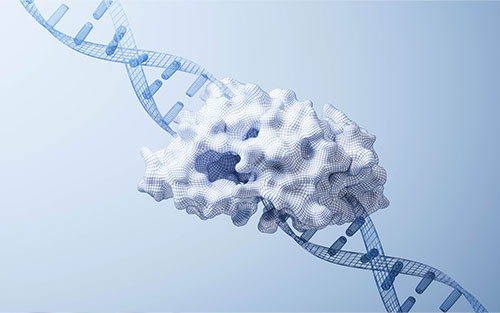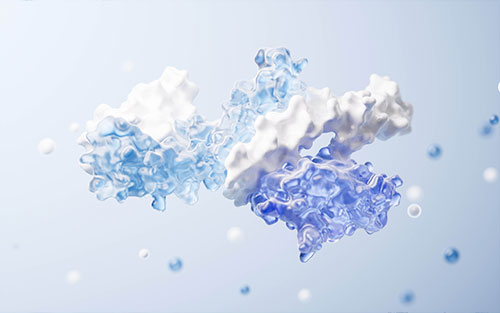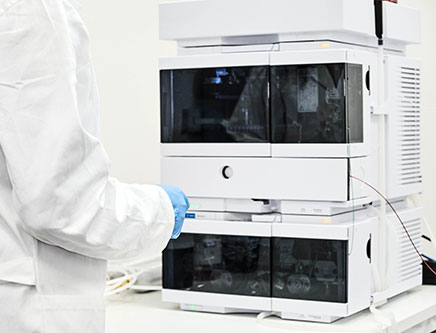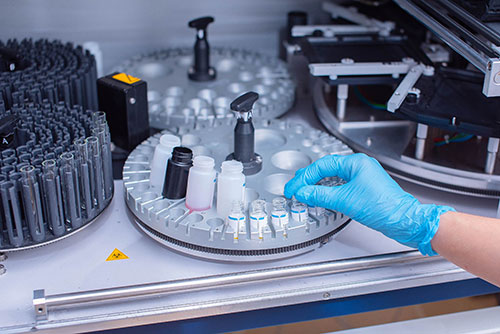In the field of biomedicine, the development of nucleic acid technology has always attracted significant attention. From the initial discovery of the DNA double-helix structure to the widespread application of gene editing technology today, nucleic acid technology has continuously driven advancements in life sciences. However, traditional nucleic acids face numerous challenges in practical applications, such as poor stability and susceptibility to enzymatic degradation. Against this backdrop, peptide nucleic acid (PNA) has emerged as a novel nucleic acid analogue. With its unique structure and exceptional properties, PNA offers new hope and opportunities for biomedical research.
Peptide nucleic acid (PNA) is a structural analog of deoxyribonucleic acid (DNA) with a neutral amide bond as the backbone. As a new molecule formed by replacing the ribose phosphate backbone in nucleic acids, it has many advantages that DNA/RNA does not have, so it has a very wide range of molecular biological effects, especially in the diagnosis and gene therapy of diseases. PNAs can alter gene expression, including inhibition of transcription and translation, gene activation and mutagenesis, and gene delivery. In recent years, PNA has been used in gene therapy, biosensors and diagnostics. Furthermore, due to its neutral charge, PNA can bind to complementary DNA or RNA with high affinity and specificity, resulting in a more stable hybrid than naturally occurring RNA or DNA.

Phosphodiester linkages hold the alternating ribose (deoxyribose) and phosphate sugars that make up the molecular backbone of DNA and RNA together. In contrast to nucleic acids, PNA is mostly composed of repeated N-(2-aminoethyl)-glycine units, which are connected by amide bonds (peptide bonds; see the blue portion of Fig. 2). The same is that they all contain nucleobases with side chains. The N of the glycine moiety on the main chain of the PNA molecule is fused to a variety of purine and pyrimidine bases (red portion in Fig. 2) via an acetyl structure (green part in Fig. 2). It can be said that PNA combines the characteristics of two distinct macromolecules, peptide and nucleic acid. PNA appears as a poly-N-(2-aminoethyl)-glycine polypeptide with base side chains when viewed as a whole.

γ-Peptide nucleic acid (γ-PNA) is a specialized type of PNA that incorporates an additional γ-amino acid residue in its structure. This structural feature enhances γ-PNA's stability and significantly improves its target nucleic acid binding affinity.

Antisense peptide nucleic acid (antisense PNA) is a type of PNA designed to bind to specific mRNA sequences. Its mechanism of action involves hybridizing with the complementary sequence of mRNA, thereby blocking the translation process and achieving gene silencing.

Anti-gene peptide nucleic acid (anti-gene PNA) is a type of PNA capable of binding to specific sequences within genomic DNA. By hybridizing with the complementary DNA sequence, anti-gene PNA inhibits transcription, leading to gene silencing.

Aptamers are nucleic acid sequences capable of specifically binding to target molecules. Aptamer peptide nucleic acid (aptamer PNA) is a complex formed by combining aptamers with PNA, enabling specific recognition and binding of target molecules.
Peptide nucleic acid building block refers to the fundamental chemical monomers used for synthesizing PNA molecules. These typically include PNA monomers containing nucleobases (A, T, C, G) and their derivatives. These building blocks polymerize through solid-phase or solution-phase synthesis methods to form PNA chains. Due to its high affinity for DNA/RNA, exceptional stability, and resistance to enzymatic degradation, PNA has been widely applied in molecular diagnostics, gene detection, antisense therapy, and nanobiotechnology.
The development and innovation of PNA analogs represent a key research direction in PNA technology. Through chemical modifications, scientists can further enhance PNA properties and expand its applications. Common PNA analogs include variants with different side-chain groups, each exhibiting distinct characteristics in terms of stability, binding affinity, and biocompatibility.
Currently, similar to solid-phase peptide synthesis, solid-phase peptide nucleic acid synthesis is used to synthesize PNA. This method uses the synthesis technology of 9-fluoroalkenylmethoxycarbonyl (Fmoc) peptide. The amino skeleton in the monomer is protected by Fmoc. This method combines PNA with peptides and labels such as biotin or fluorescent dyes. Each synthesis cycle takes approximately 30 minutes and is mainly divided into the following steps:
BOC Sciences offers high-quality PNA synthesis services, specializing in custom synthesis of peptide nucleic acid sequences, including chemical synthesis, purification, and modification. Our services are suitable for various fields such as research, clinical studies, and drug development, meeting diverse customer needs in sequence design, yield requirements, and quality control. With advanced technology and a professional team, we ensure that each synthesis project is delivered on time and meets high-quality standards.
The design strategies and methods of PNA are critical aspects of PNA research. When designing a PNA sequence, multiple factors must be considered, such as the target nucleic acid sequence, the length of the PNA, and its nucleotide composition. The fundamental design principle is to select a PNA sequence complementary to the target nucleic acid to achieve optimal binding efficiency. However, practical design also requires consideration of additional factors, including the stability, binding affinity, and specificity of the PNA.
Peptide nucleic acids have unique advantages in the field of probes due to their excellent chemical and biological stability and flexibility in chemical synthesis. Peptide nucleic acid probes generally refer to short peptide nucleic acids of 13-18 bases with a specific sequence, and their length is shorter than DNA probes. The electrically neutral backbone gives it a higher hybridization affinity than DNA. At the same time, the specificity of base pairing is also significantly improved, and different nucleic acid sequences can be distinguished through single base mismatches. Hybridization conditions are also milder than DNA probes and do not affect hybridization at low salt concentrations. Moreover, the non-natural peptide skeleton can resist degradation by nucleases and proteases and has high biological stability.
Although PNA is very similar to DNA/RNA, PNA monomers are connected to each other through an unnatural peptide bond. Therefore, PNA has the properties of both peptides and nucleic acids, and has its unique advantages:
Compared with the negatively charged ribose phosphate backbone of DNA and RNA, the backbone of peptide nucleic acid is uncharged, which reduces the repulsion between its double strands and thus has higher affinity and stability than DNA or RNA.
Since peptide nucleic acids are artificially synthesized nucleic acid-like substances and do not contain amino acid residues or pentose phosphate units in their structure, most nucleases and proteases cannot effectively degrade them.

The achiral conformation of peptide nucleic acids facilitates monomer synthesis and purification. The backbone contains repeated amide bond structures, so solid-phase synthesis methods can be used to synthesize oligomers.
Compared with other oligonucleotide analogs such as locked nucleic acids, peptide nucleic acids have better specific recognition ability of target sequences.
PNA has broad applications in gene diagnosis, molecular probes, antisense gene therapy, and drug development. It can be used for detecting gene mutations, labeling nucleic acid sequences, inhibiting specific gene expression, and serving as a key component of targeted delivery systems. Due to its resistance to enzymatic degradation, PNA demonstrates great potential in biomedical and nanotechnology fields, providing essential tools for precision medicine and molecular biology research.

PNA can specifically inhibit viral gene expression and replication by binding to viral nucleic acids, thereby disrupting the viral life cycle. Additionally, PNA can modulate the immune response of host cells, enhancing the body's defense against viral infections. This dual mechanism of action makes PNA a promising tool for combating various viruses, including influenza virus, HIV, and coronaviruses.
PNAs play a significant role in gene editing technologies. Unlike the CRISPR-Cas system, PNAs induce targeted modifications by triggering double-stranded DNA cleavage, potentially reducing off-target effects. PNAs can stimulate the cell’s own repair pathways to correct disease-causing mutations. They can also be used for gene silencing by effectively blocking specific DNA or RNA sequences. Moreover, PNAs can be combined with CRISPR-Cas9 or TALENs to guide nucleases to specific sites, resulting in targeted DNA cleavage and gene editing.
PNAs have emerged as a powerful tool for gene silencing. By targeting specific regions of DNA and RNA, PNAs regulate gene expression at multiple levels, including transcription and translation. PNAs inhibit transcription or translation by binding to complementary DNA or RNA sequences, effectively knocking down gene expression. This targeted approach enables the study of gene function and the development of therapeutic interventions for various genetic disorders.
The neutral backbone of PNA enhances its stability when binding to complementary nucleic acids, eliminating electrostatic repulsion effects. Leveraging this property, PNA can be used to construct highly sensitive and specific nucleic acid sensors. For instance, PNAs designed with specific sequences enable precise detection of gene mutations and pathogenic nucleic acids. Additionally, PNAs can be combined with fluorescent probes to further enhance detection signals, providing a powerful tool for early disease diagnosis.
PNA exhibits vast potential in the field of supramolecular drugs. Through self-assembly, PNA can form various supramolecular structures, such as microgels and hollow capsules. For example, by utilizing the complementary binding of PNA and DNA, functional supramolecular drug delivery systems can be constructed. Furthermore, PNAs can be employed in the development of reversible supramolecular drugs, such as anticoagulants. By modulating PNA binding and dissociation, drug activity can be switched on and off, enabling rapid reversal of drug effects when necessary.
The metabolic stability and strong binding affinity of PNA make it an exploitable tool for reverse gene therapy. PNAs are steric blockers that inhibit splicing or translation of target mRNAs by binding to the start site. A PNA molecule modified with four lysines at the C terminus was shown to be effective in correcting abnormal splicing in transgenic mice, demonstrating its potential as a therapeutic agent. In another study, GPNA (α-guanidine-modified PNAs) was successfully used to inhibit the expression of EGFR, an important driver of non-small cell lung cancer, in a mouse model.
Peptide nucleic acid (PNA) is a synthetic DNA/RNA analog in which the sugar-phosphate backbone is replaced by a neutral peptide-like backbone, typically composed of N-(2-aminoethyl)glycine units. Despite lacking charged phosphates, PNA retains strong Watson-Crick base pairing with complementary DNA and RNA. Its high stability, resistance to enzymatic degradation, and strong hybridization properties make it valuable in molecular diagnostics, gene therapy, and antisense applications.
A peptide nucleic acid (PNA) helix is formed when PNA strands hybridize with complementary DNA, RNA, or another PNA strand through Watson-Crick base pairing. Due to its flexible yet rigid backbone, PNA adopts a right-handed helical structure similar to B-DNA when bound to nucleic acids. PNA-DNA duplexes often exhibit higher thermal stability than DNA-DNA duplexes, and PNA can also form triplex or duplex invasion complexes, which enhances its applications in gene targeting and molecular recognition.
Peptide nucleic acids (PNA) have a wide range of uses. They can be used in gene editing, such as combining with CRISPR-Cas9 to achieve precise gene modification. In gene therapy, PNA can act as antisense drugs to inhibit the expression of specific genes. It can also be used as nucleic acid hybridization probes. Due to its high stability and specificity, it is suitable for in situ hybridization.